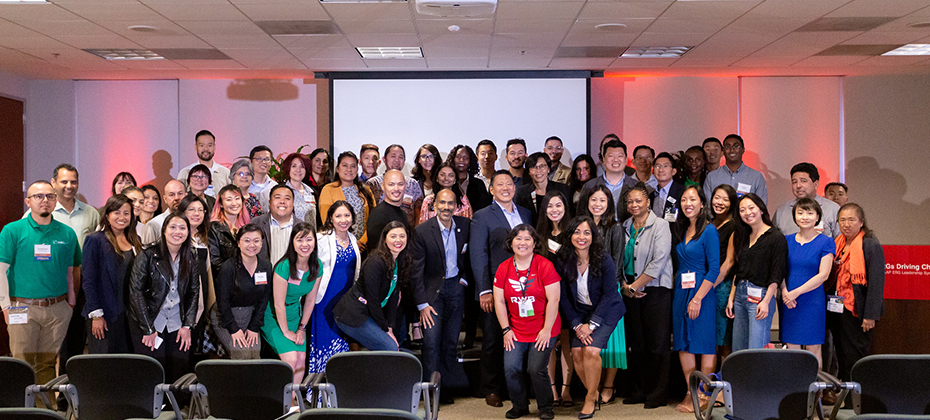All posts by Editor

At Experian we’re committed to creating a culture of continuous innovation, from the way we work to the solutions we create. This commitment has helped us create a workplace where our teams across the world have a desire to help change the lives of millions for the better. Justin Hastings, former Chief Human Resources Officer for Experian North America, recently wrote an article for the Forbes Human Resources Council which highlights the importance of creating an inclusive environment in the workplace -- and demonstrates how innovation, developing new products and services, and providing value are all crucial to a companies’ success. The article, “Deliver Innovation By Embracing Inclusion,” explores what it means to build a culture of innovation, and how to ensure employees feel comfortable bringing their different backgrounds and ideas to their role every day. This is the type of innovative culture we’re building at Experian, which celebrates these differences and works to make employees feel valued and empowered to be innovative and productive. Another concept Justin discusses in this article is “innovating to grow.” It’s important to make employees feel connected to their organization and involved in the creation of new products and services. This has a tremendous positive impact with employees providing valuable feedback, and also creating advocacy among team members. For example when developing Experian Boost, which has helped millions of people raise their credit scores, we first beta-tested and shared the innovation internally and were able to garner valuable feedback and support from employees. As a result, we’ve seen tremendous success since the launch of Experian Boost earlier this year. At Experian we truly believe that inclusion is the key to creating a culture of innovation. You can read the full article here.

For the second year in a row, Experian Costa Rica has achieved recertification from Great Places to Work in the Central America region. The honor recognizes the inclusive workplace culture that Experian Costa Rica employees and leaders have created, making it a dynamic environment for innovation and high productivity. “Getting re-certified as a Great Place to Work provides and enormous sense of pride. As an organization it validates all the efforts we make to ensure a strong healthy employee culture and as a leader it allows us to come to work knowing that we have a culture that employees enjoy working in,” said Adrian Sibaja, Director of Service Delivery for Experian Costa Rica and Chile. Experian Costa Rica is one of four Global Delivery Centers, strategically located centers of operational excellence that support Experian’s regions. The office is home to nearly 1,000 employees across different business units. This honor reinforces the workplace culture we’re fostering, which our employees are happy to brag about in confidential surveys. Costa Rica leadership is always looking for ways to make the employee culture even better. That’s why recognizing employee accomplishments and encouraging partnership between business units are among their top priorities. Congratulations to our Costa Rica colleagues!

Eva lets out a deeply frustrated exhale as she navigates moving boxes in her new apartment towards a nearby chair. She was just trying to update her address online and take care of some online banking money transfers. Now her accounts are frozen, and she has received a message to call the bank's fraud department. How could she be a fraudster? She was only guilty of taking a job and moving to Chicago. Maybe it's time to start thinking about changing banks... Meanwhile, in the bank's Texas-based fraud department, Robert spots Eva's case in his fraud investigations list. He noticed some suspicious activities and leaves Eva a voicemail, wanting to ask her a few questions to verify her identity or otherwise confirm this is in fact a fraudster infiltrating Eva's account. To prevent this potential risk of fraud from escalating, Robert decides it is better to freeze Eva's accounts while he confirms that it's actually Eva who is trying to change her address and not a fraudster using a stolen password. As both Robert and Eva work to connect and clear up this mix-up, Robert isn't getting to spend his time finding actual fraud and protecting his bank from any potential losses. Fraud hubs bring together advanced authentication technology and risk mitigation systems into a single platform As fraud attacks grow more frequent and complex, new technologies have sprung up to help meet the challenge, using a variety of tactics and tools to detect fraud. This is the case of device recognition, malware detection, identity verification, behavioural biometrics, and document verification, just to name a few. Regardless of their choice of tools and techniques, businesses across banking, retail, telecommunications, healthcare, and services industries need to know that the person interacting with them online is who they say they are. Combating fraud with layered tools strengthens businesses' defenses. But without an intelligent approach to connecting those tools, businesses catch too many good customers (like Eva) in their fraud-mitigation nets. By bringing together different types of fraud mitigation and risk management systems on a single technology platform, fraud hubs provide a solid solution to this challenge. How do fraud hubs like CrossCore help both businesses and consumers? CrossCore brings together into a single platform best-in-class tools and services such as advanced analytics, data consortium, device recognition, endpoint malware, and bot detection, behavioural biometrics, and document verification. Experian has also been named by Gartner as a representative vendor in online fraud detection in their April 2019 Market Guide for Online Fraud Detection, for its CrossCore solution.* Our flagship identity and fraud hub connects various functionalities together in a smart, orchestrated way, leveraging machine learning-driven decisioning to deliver a single fraud decision across multiple tools and enabling businesses worldwide to improve their fraud detection capabilities. CrossCore equips businesses with the most applicable tools to combat the specific fraud threats they face in their organisation. The 100 million cumulative transactions we have run on CrossCore to date show us that while one client may need additional protection against synthetic identity fraud, another may face frequent bot attacks in their account opening application, therefore requiring different approaches. It also means that if one tool can't validate a user's identity, another system can provide evidence that this is, in fact, a real customer. It's precisely the advanced analytics underpinning data modeling what gives our clients greater confidence in their identity and fraud decisions. But let's go back to Eva. In her case, CrossCore's fraud risk engine would have fired rules when she was making a change of address, as this action elevates the potential for fraud. But CrossCore's device intelligence would have shown that Eva was logging in from a known mobile phone. She was also using her phone to type information in a way that a normal user (non-fraudster) would do. In that case, CrossCore would have asked for a step-up authentication where Eva is prompted to take a selfie for biometric authentication. Now, Eva can continue to do her banking and access her accounts as she would normally do. This is a relief as Eva checks off more moving-related tasks and can enjoy her new life in a new city. Back in the bank's fraud investigation office, Robert and his colleagues would have never seen a case for their customer, Eva. Instead, they would have been able to focus their energies on high-risk cases, mitigating any emerging fraud threats. They would have also treated Eva as the good, valued customer she is and helped ensure her business in the long run. Whether it's an automotive client in South Africa, a healthcare organisation in the U.S., an insurance company in the UK, a fintech in Australia or a bank in Brazil, CrossCore is helping to solve one of the greatest challenges in decision analytics today: identifying good customers, while reducing fraud. Download the 2019 Global Identity & Fraud Report. *Gartner does not endorse any vendor, product or service depicted in its research publications, and does not advise technology users to select only those vendors with the highest ratings or other designation. Gartner research publications consist of the opinions of Gartner's research organization and should not be construed as statements of fact. Gartner disclaims all warranties, express or implied, with respect to this research, including any warranties of merchantability or fitness for a particular purpose.

As a member of the Forbes Technology Council, I get to publish articles on some of the latest technology trends and best practices. A recent piece, entitled “Are we comfortable with machines having the final say?”, deals with the sensitive issue of decisions being made by complex algorithms and how it impacts all areas of our lives. The article takes a closer look at high-impact decisions, such as loan determinations and health diagnosis, where the lack of understanding how algorithms may be used is becoming of increasing concern. In this context, it raises the importance of Explainable AI (XAI). This is a concept where technology and science are being used to explain how an algorithm or machine reaches a decision and tries to do this in a way that is transparent to users. However, this approach is still being tested and is only used in certain limited circumstances. As humans, we are taught to explain our decisions but we all know how difficult it is - and science has repeatedly shown how easily biased we are. XAI still has some way to go, but we can inspect, test and pick machines apart in a way we can never do with the human mind. So perhaps one day we will find a way to truly explain a machine’s decision. Whether that would make us comfortable with the machines having the final say, is still to be seen. Check out the full article here.

Phishing attacks have become more sophisticated and personal. We are all busy with life – work, family, commute, and dinner plans, along with keeping up on the latest news cycle. Virtually anyone could be inclined to quickly click on a link stating there is an issue with their recent order. But there's more to phishing attacks than just baiting businesses and consumers. During a recent #ExperianLive event, Mike Gross, Head of Global Identity and Fraud Product Innovation, discussed what businesses can do to protect themselves and their customers. Q: You say that phishers would make good digital marketers. What do you mean by that? Mike: Like a great marketer, a good phisher understands people and their tendencies; they know how to get people to take action on their message. Take my most recent “almost phishing" incident. During the holidays, I received an email from a top online retailer stating there was a “problem with my recent order." I knew that any delay would jeopardize my holiday gift delivery. I was just about to click the “Login" button and then stopped. Thankfully, I double-checked the sender and it wasn't my favorite shopping site after all – just a really good fake email from a "phishy" sender. Like a digital marketer, phishers understand how to specifically target the things that people care about. This is why phishing attempts focused around the holidays, tax season, natural disasters, and hot news topics are often so successful. Q: Are phishers counting on the relationship and roles people have in an organization? Mike: Yes. That's the whole nature behind one of the biggest phishing attacks over the past several years – business email compromises. As a phisher, I'm sending you an email that looks like I work with you, say a vendor with a message that reads, “I changed the account that you use to pay me; please update your payment to this new account." If there is urgency behind it, it is taken seriously - for example, to avoid being late on paying a vendor. Human nature is being helpful and reacting, especially in this fast-paced, hyper-connected world – and that's why these scams continue to work. Q: What other phishing trends are you seeing? Mike: They've evolved over time. Take the simple phishing email; it's not so simple anymore. Nowadays, attacks are personalized to both the business and specific person – and phishers are taking advantage of automation and targeting tools so they can get the most reward for their effort. “Smishing" is variant of phishing focused on the phone channel, where attackers target victims with an SMS-based attack; you've probably seen them. You get a text and link from what you think is your friend saying something like “Check out this funny video!" But it isn't legitimate; it's a fraudster that is spoofing your friend's phone number. Then there is “vishing" which is a voice-based attack. This is where a fraudster pretends to be someone they're not (like a consumer's financial institution) and tries to obtain personal information or take over an existing account. Q: Wow! Phishing fraud is sophisticated. What has led to that? Mike: We've seen a tremendous leap in technology used. There is a great example of that last year with a U.K. bank. Their customers expect that if there is an out-of-place transaction, the bank will call them. In this particular vishing scheme, vishers used compromised accountholder usernames and passwords to log into customer accounts and set up money transfers. Knowing that this would alert accountholders to the attempted transfer using the SMS one-time passcode, phishers called legitimate customers, impersonated the bank, and stated that since the customer was a recent fraud attack victim, the bank needed confirmation that they were the accountholder. The vishers told customers they would receive a passcode. While the customer confirmed the code, the vishers submitted the fraudulent transfer. Q: What trends and techniques are you seeing? Mike: Two of the big trends we're seeing is around Artificial Intelligence (AI), machine learning, and SMS to find victims. A big part of phishing is what we call “spear phishing." This targets individuals with access to an organization's financial accounts or internal systems. Another term is “whaling" which targets a specific high-profile individual. The phishers are no longer just sending out blanket lottery scam and Nigerian prince emails with misspellings to millions of people. It's very focused – and phishers can easily do this using machine learning and AI. Q: Do you notice any seasonality, or spikes in phishing based on a certain time of year? Mike: The holidays are one because so many people go to their favorite shopping sites and buy items that are completely out of pattern based on what they usually do online. Another good example is tax season. We saw phishers impersonate top tax and financial management software providers, allowing consumers to “quickly and easily submit their tax forms online." What's worse is that phishers use the knowledge you have about phishing against you. Things like “How do you protect yourself? Click on this link to learn more" or “Click this link to download software and protect your devices." Also, fraudsters pay attention to the news, so whether it's a natural disaster or the cathedral fire that happened in Paris last April, phishers see those as opportunities to prey on victims simply trying to donate to a worthy cause. Q: What advice do you have for businesses and consumers to protect themselves against phishing attacks? Mike: My advice for businesses is to focus on technology and training. Strong technology solutions must be in place at all businesses to block phishing emails that are coming from suspicious sites – and for the most part, large organizations do a great job of that. Smaller businesses can also take advantage of technology solutions from their internet providers. Businesses can implement web blocking software for less secure Internet sites and filter what types of content employees can have access to on business devices. A lot of companies hire outside consultants to talk about the different types of phishing attacks with employees. These are helpful, but the key is to not allow training to become static because attackers evolve so quickly. Both businesses and consumers can use the email filtering option that is available through nearly every email provider. Don't click on any attachments that even remotely look suspicious - especially if they've been texted to you from someone you either don't know or the message appears out of character for someone you know. Q: What activities is your group taking on that will help businesses and their customers fight phishing attacks? Mike: There are several things we're doing that impact businesses and consumers offline and digitally. We help businesses recognize their customers and authenticate them, whether that's helping customers with a new bank account, enabling easy checkout at a favorite retailer app, or protecting account logins. 99% of people trying to access accounts are the legitimate account holder; it's that 1% though that causes a lot of friction for good customers. So, we're trying to make it easier for those consumers to quickly pass through all of the controls so authentication is easier. That translates into consumer loyalty for brands. Q: And that's what it's really all about? Mike: It is. We help businesses recognize their customers and also ensure that they are catching fraudsters on the back end. But we also strive to make that recognition or user experience as seamless as possible, with the right scrutiny for the risk level of that business. Mike Gross leads product innovation strategy for Global Identity and Fraud at Experian. Check out the entire podcast and video on how to protect your business from phishing here.

Across the globe, fraud risks continue to grow and businesses continue to invest more to combat potential threats. According to Experian's 2019 Global Fraud and Identity Report, which was published this past January, more than half of businesses across the world have increased their fraud management budget in the past twelve months. I recently had the opportunity to discuss this very topic with Forbes.com. In the article I raised the issue of whether businesses are investing in the right places. Our research shows that businesses may sometimes be investing in the wrong capabilities or point solutions that are materially less effective than if they were to take a layered approach to fraud detection. To provide consumers with both security and convenient online experiences, companies must have a complete understanding by looking at the problem holistically. By layering multiple approaches such as digital risk assessments leveraging device intelligence, behavioural biometrics together with more traditional measures – businesses can focus their resources where it matters most – providing a safe yet convenient online environment for their customers. The Forbes article also looked at the issue of trust. The anonymous nature of digital interactions makes creating trusted and meaningful relationships with digital consumers difficult. Unlike face-to-face interactions where people rely on visual cues, and relationships developed over time, businesses must find other ways to quickly recognize their customers online and deliver personalized experiences. At Experian, we believe trust is extremely important. In fact, the report found that nearly eighty percent of consumers say the more transparent a business is about the use of their information, the greater trust they have in that business. And fifty-six percent of businesses plan to invest more in transparency-inspired programs such as educating consumers, communicating terms more concisely and helping consumers be in control of their data. There is no doubt about it, businesses who want to continue to thrive and lead in the digital economy will find ways to offer their customers both security and convenience whilst building trust with their audience. Learn more the state of fraud and how trust plays a role by downloading our 2019 report: Consumer trust: Building meaningful relationships online.

We are delighted to announce our investment in bonify, a German fintech start-up dedicated to giving consumers better insights into their creditworthiness. bonify gives its 500,000 customers easy access to their creditworthiness and financial data, offering them a number of financial management tools to help analyse and optimise their financial situation. At Experian, we believe very deeply in the power of data to help improve people’s lives. That’s why we’re so excited by bonify’s continued goal to improve its users’ financial lives, and the steps it is taking to help people in Germany understand and benefit from their financial information. We are delighted to join a number of investors in supporting the growth of this innovative start-up. Charles Butterworth, Managing Director Experian UK, Ireland and EMEA, said: "We are excited by the way bonify is helping people in Germany understand, engage with and improve their credit scores. We look forward to supporting the team as an investor and partner in their future growth.“ Founder and CEO of bonify, Dr. Gamal Moukabary, said: “Experian's investment shows that we are on the right track. It rewards our achievements and our unique value proposition. Experian is an ideal investor and partner for us to support the next growth phase. Our goal is to expand our operations into other European countries.” Manuel Silva Martínez, Partner and Head of Investments, Santander InnoVentures, added: “We are delighted to welcome Experian Ventures to bonify. Experian will add tremendous value and technical expertise to bonify’s product roadmap. We are thrilled to support bonify as we accelerate growth and help more and more people across Germany and Europe with taking control of their finances in a sound and responsible way.

In the United States, June is observed as Pride Month by the Lesbian, Gay, Bisexual, Transgender and Queer (LGTBQ+) community. The celebration is in remembrance of the 1969 Stonewall Uprising in Manhattan, a tipping point for the Gay Liberation Movement in the U.S. Pride is not only about the parades and flags, but about the celebration and commemoration of the contributions members of the LGBTQ+ community have made throughout U.S. history—and there are many. Though the beginnings of Pride Month originate in the U.S., Experian is committed to supporting and uplifting the LGBTQ+ community on a global scale. This year was an especially important year, marking both the 50th anniversary of the Stonewall Uprising and the one year anniversary of the inception of Experian’s Pride Network Employee Resource Group (ERG). Our Pride Network executive co-sponsors, Michele Bodda and Todd Rudie, say, "As our culture continues to evolve, we feel especially empowered by Experian’s demonstrated commitment to diversity and inclusion. With great support from our leadership, we launched the Experian Pride Network just one year ago and have achieved success beyond our aspirations." Earlier this year, for example, Experian earned a "2019 Best Place to Work for LGBTQ Equality" designation by the Human Rights Campaign (HRC). "We are proud to have achieved a perfect score on our very first submission to HRC’s Corporate Equality Index. This was a goal our ERG originally set out to achieve within three years," Bodda and Rudie stated. With so much to commemorate and celebrate, our Pride Network kicked off the month with numerous events around the world, including participation in official Pride parades, on-campus barbecues, bake-offs, spirit days, LGBTQ-focused webinars and so much more. It's important for us to not only provide a safe space for members of the LGBTQ+ community, but to also educate all of our non-LGBTQ employees about how they can be better allies. As part of the festivities, we had The LGBT Center OC conduct a webinar for ways we can develop tools and strategies for good allyship across the LGBTQ+ community and beyond. Here are some takeaways of what it means to be an LGBTQ+ ally: Allies have a deep understanding of LGBTQ+ people, terms, and experiences Allies speak up when they see discriminatory behavior Allies intervene in cases of bullying or harassment Allies always use the right name and pronouns for their transgender friends Allies recognize that they have privilege over other marginalized groups, and they want to use that privilege to help elevate the voices of the unheard Experian also hosted a webinar on navigating the workplace as a transgender individual. While several states have laws in place to protect transgender and gender non-conforming individuals in the workplace, harassment and discrimination are still large issues in the U.S. today. Here are some takeaways of what we can do to better support our transgender and gender non-conforming colleagues and friends: Understand the biases and hardships trans and gender non-conforming individuals face in the workplace — 75 percent of transgender workers experience discrimination, harassment, bullying, privacy invasion and suppression every day at work Know the laws in your state Empathize. You can do this by calling people by the preferred name/pronoun, refraining from making assumptions about others' sexual orientations and avoiding making assumptions that all trans people look the same or are going through a "transition" Be an ally — add gender neutral/all-gender restroom options, normalize the usage of pronouns, don't ask personal or inappropriate questions, etc. After taking measures to further educate ourselves, it was time to celebrate! Here are some photos from our Pride celebrations: Costa Mesa, CA Allen, TX Schaumburg, IL Clearwater, FL Costa Rica

As part of Experian’s commitment to the value of Employee Resource Groups (ERG), we recently hosted the National Association of Asian American Professionals (NAAAP) ERG Leadership Symposium, ERGs Driving Change at our Costa Mesa headquarters. ERGs are a proven strategy for organizations to advance a diverse and inclusive company culture. At Experian, we believe the culture of inclusion also cultivates and advances innovation with the added diversity perspective that strengthens the community of professionals and ideas within the company. We were proud to host the 13th ERG one-day training program that was organized by the NAAAP to help companies and employees advance their ERG experience and learn how ERGs are change agents to enhance productivity and grow professional networks in the corporate setting. Speakers represented companies leading their industry, such as Bank of the West, Macy’s, Anheuser-Busch, Google, Facebook, UPS, Northrop Grumman, Boston Scientific, and many more, including Experian. The symposium this year featured numerous ERG thought leaders sharing their insights across a variety of sessions and panels, including; Best Practices in Demonstrating Value, Creating Connections through ERG Leadership, What’s Next Action Plans for Your ERG, among others. Caption: Hiq Lee, President, Business Information Services for Experian, shared insights as a panelist for The Crucial Executive Role in Driving Change session. She was joined by Judy Ting, SVP, Pacific Rim Region Manager, Bank of the West, and DeAnne Aussem, Managing Director & Founder of U.S. Leadership Coaching Center of Excellence, PricewaterhouseCoopers, LLC. The panel was moderated by Farzana Nayani, NAAAP ERG Architect. All speakers provided valuable takeaways for the professionals in attendance to motivate their organizations to positively impact their company with the diversity amongst its workforce and implement strategies to leverage the power of inclusion. Specifically, the hundred-plus attendees learned more about how Employee Resource Groups and Business Resource Groups are change agents for diversity, inclusion, engagement, productivity, and connection-building within organizational settings. Justin Hastings, former Chief Human Resources Officer for Experian North America, welcomed the ERG Leadership Symposium attendees with his introductory remarks, as he shared Experian’s perspective on inclusion leading to innovation. Therefore, we asked him some questions to share his insights with us on Experian’s ERGs. 1. How is Experian creating a better tomorrow? Hastings: The consumer is at the heart of everything we do. Our product innovation is geared towards giving consumers more control over how their data can enrich their lives. Experian Boost is a perfect example of this coming to life. Inclusion underpins our ability to innovate. The more we encourage a culture where everyone’s creativity is valued, the more we are able to innovate for consumers. Our ERGs play an important role in promoting diversity, and creating an environment where all our Experian people can bring their whole selves to work and be creative. 2. What role does The Power of YOU have in Employee Resource Groups? Hastings: We created a workplace environment where everyone is comfortable bringing their whole self to work, regardless of differences or backgrounds. We call this The Power of YOU, which creates an environment for employees to be their true selves. We advance our company culture by not only respecting the differences amongst Experian colleagues, but actively celebrating them with and through our ERGs. 3. What impact does the Employee Resource Groups have on Experian? Hastings: At Experian, inclusion is vital to the success of the company. Our ERGs provide us with a platform to be a more innovative business. Our ERGs now have around 1,000 employees actively involved across the eight current groups. They have helped create greater understanding of different cultures that are represented in our company, and they have also underpinned our recruiting efforts across diverse talent pools. This has helped us to keep evolving our employee base to be increasingly representative of the communities in which we operate, and the consumers we ultimately serve. Learn more about Experian’s Employee Resource Groups by visiting: https://www.experian.com/corporate/power-of-you.html Learn more about the National Association of Asian American Professionals (NAAAP) by visiting: https://www.naaap.org/ All photos taken by Nhan T. Nguyen.